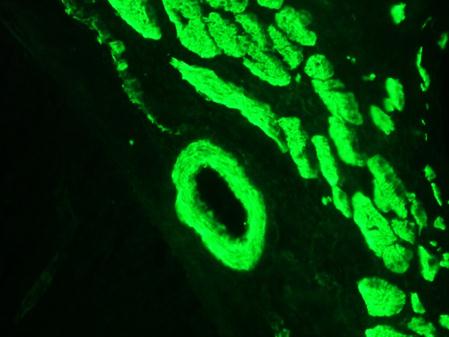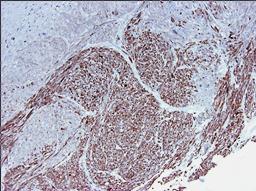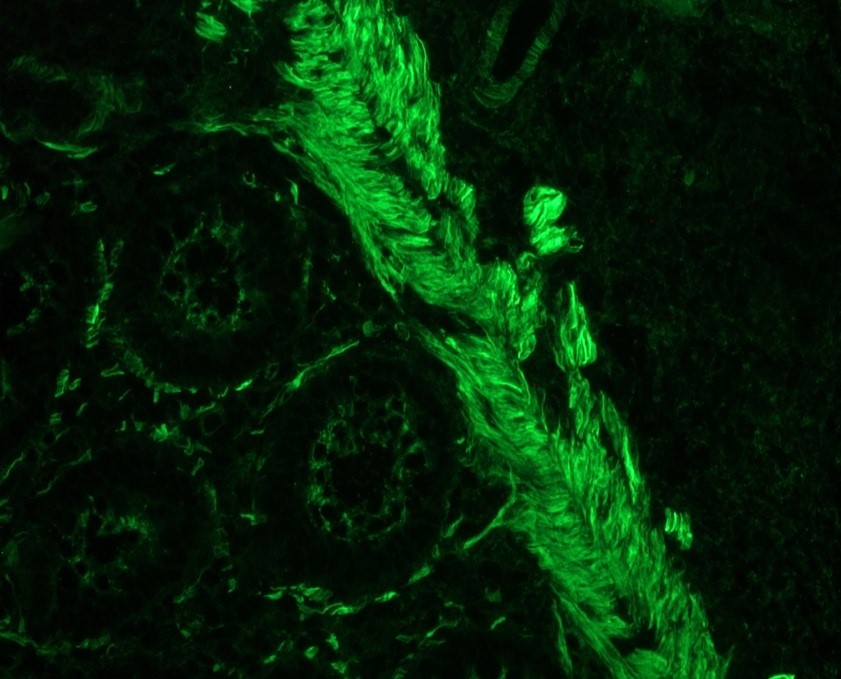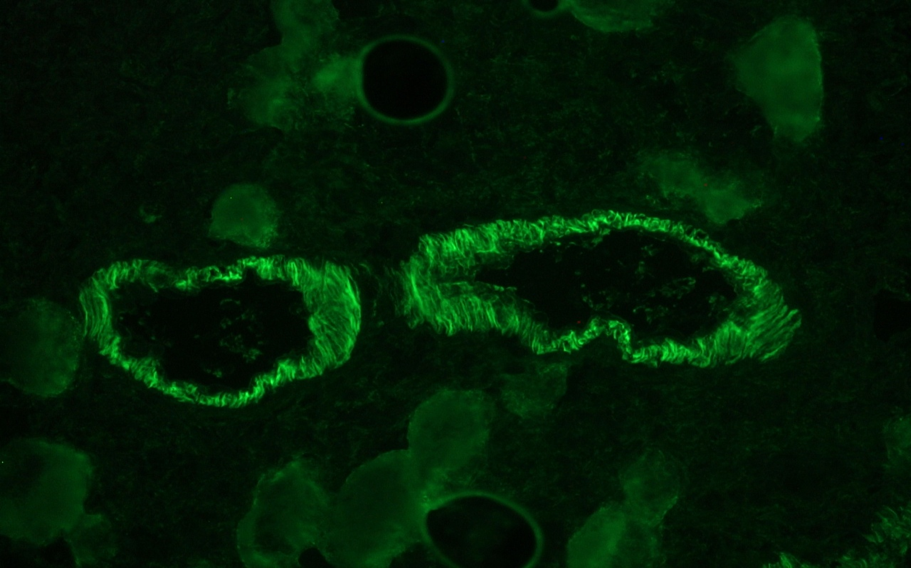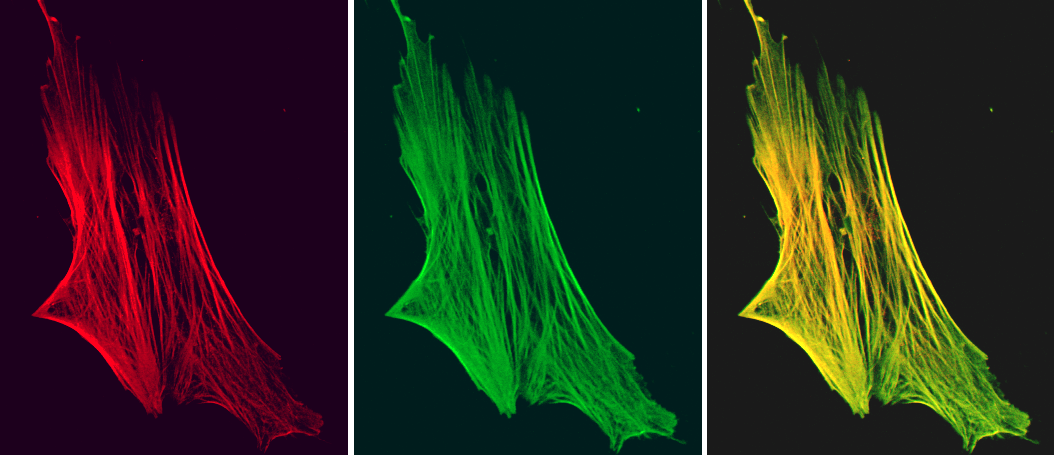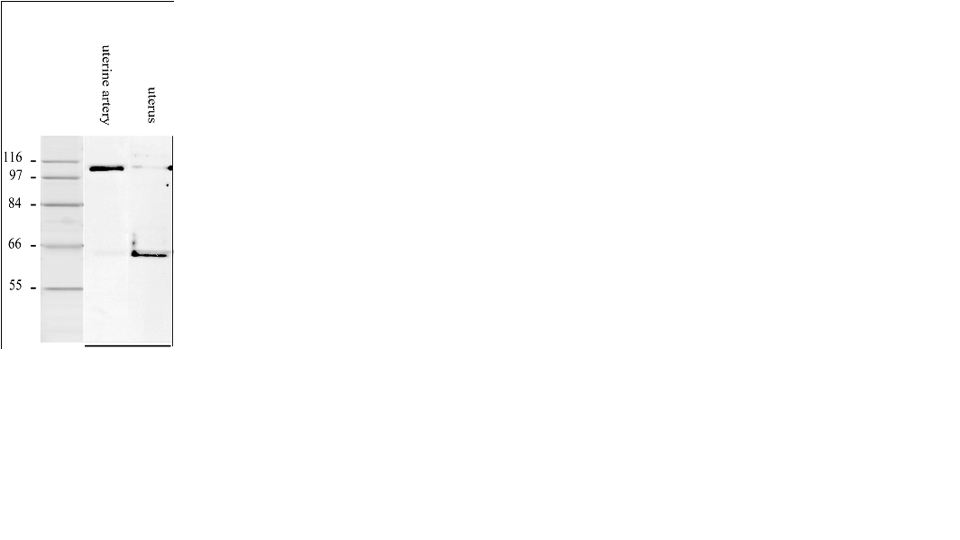Catalogue

Mouse anti Smoothelin
Catalog number: MUB1700P| Clone | R4A |
| Isotype | IgG1 |
| Product Type |
Primary Antibodies |
| Units | 0.1 mg |
| Host | Mouse |
| Species Reactivity |
Canine Chicken Feline Human Monkey Swine |
| Application |
Immunocytochemistry Immunohistochemistry (frozen) Immunohistochemistry (paraffin) Western Blotting |
Background
Smoothelin is a constituent of the smooth muscle cell (SMC) cytoskeleton. Antibodies directed to smoothelin are useful tools to monitor SMC differentiation. Smoothelin is exclusively expressed in fully differentiated (contractile) SMCs. RNA and protein analyses revealed a broad species distribution of this protein. Smoothelin has also been detected in smooth-muscle neoplasms. Cells with SMC-like characteristics, such as myofibroblasts and myoepithelial cells, as well as skeletal and cardiac muscle do not contain smoothelin. Confocal scanning laser microscopy of tissue sections and cells in culture show a filamentous organization of smoothelin colocalizing with actin stress fibers. In immunoblots two molecular weight isoforms are detected i.e. a 59 kDa isoform specific for visceral SMC (smoothelin A), and an isoform with a molecular weight of approximately 100 kDa in vascular SMC (smoothelin B). Human smoothelin is encoded by a single copy gene which is loCated on chromosome 22.
Source
R4A is a mouse monoclonal IgG1 antibody derived by fusion of SP2/0-Ag14 mouse myeloma cells with spleen cells from a BALB/c mouse immunized with a cytoskeletal extract of chicken gizzard.
Product
Each vial contains 100 ul 1 mg/ml purified monoclonal antibody in PBS containing 0.09% sodium azide.
Specificity
R4A reacts with the 59 kDa and 100 kDa protein, corresponding to smoothelin A and B, respectively, which are exclusively found in smooth muscle cells.
Applications
R4A is suitable for immunoblotting, immunocytochemistry on permeabilised cells, and and immunohistochemistry on frozen and paraffin-embedded tissues. For staining paraffin-embedded tissues pretreatment in 10 mM citRate buffer (pH 6.0) and heating for 3 times 5 minutes in a microwave is required. Optimal antibody dilution should be determined by titration; recommended range is 1:100 – 1:200 for immunohistochemistry with avidin-biotinylated Horseradish peroxidase complex (ABC) as detection reagent, and 1:100 – 1:1000 for immunoblotting applications.
Storage
The antibody may be stored at +4°C. For prolonged storage prepare appropriate aliquots and store at or below -20°C. Prior to use, an aliquot is thawed slowly in the dark at ambient temperature, spun down again and used to prepare working dilutions by adding sterile phosphate buffered saline (PBS, pH 7.2). Repeated thawing and freezing should be avoided. Working dilutions should be stored at +4°C, not refrozen, and preferably used the same day. If a slight precipitation occurs upon storage, this should be removed by centrifugation. It will not affect the performance or the concentration of the product.
Shipping Conditions: The antibody is shipped at ambient temperature.
Caution
This product is intended FOR RESEARCH USE ONLY, and FOR TESTS IN VITRO, not for use in diagnostic or therapeutic procedures involving humans or animals. It may contain hazardous ingredients. Please refer to the Safety Data Sheets (SDS) for additional information and proper handling procedures. Dispose product remainders according to local regulations.This datasheet is as accurate as reasonably achievable, but Nordic-MUbio accepts no liability for any inaccuracies or omissions in this information.
References
1. van der Loop, F. T., Schaart, G., Timmer, E. D., Ramaekers, F. C., and van Eys, G. J. (1996). Smoothelin, a novel cytoskeletal protein specific for smooth muscle cells, J Cell Biol 134, 401-11.
2. Wehrens, X. H., Mies, B., Gimona, M., Ramaekers, F. C., Van Eys, G. J., and Small, J. V. (1997). Localization of smoothelin in avian smooth muscle and identifiCation of a vascular-specific isoform, FEBS Lett 405, 315-20.
3. van der Loop, F. T., Gabbiani, G., Kohnen, G., Ramaekers, F. C., and van Eys, G. J. (1997). Differentiation of smooth muscle cells in Human blood vessels as defined by smoothelin, a novel marker for the contractile phenotype, Arterioscler Thromb Vasc Biol 17, 665-71.
4. Christen, T., Bochaton-Piallat, M. L., Neuville, P., Rensen, S., Redard, M., van Eys, G., and Gabbiani, G. (1999). Cultured porcine coronary artery smooth muscle cells. A new model with advanced differentiation, Circ Res 85, 99-107.
5. Johansson, B., Eriksson, A., Ramaekers, F., and Thornell, L. (1999). Smoothelin in adult and developing Human arteries and myocardium, Histochem Cell Biol 112, 291-9.
6. Johansson, B., Eriksson, A., Ramaekers, F., and Thornell, L. E. (1999). Smoothelin and intermediate filament proteins in Human aortocoronary saphenous vein by-pass grafts, Histochem J 31, 723-7.
7. Deruiter, M. C., Rensen, S. S., Coolen, G. P., Hierck, B. P., Bergwerff, M., Debie, W. M., Gittenberger-De Groot, A. C., and Van Eys, G. J. (2001). Smoothelin expression during Chicken embryogenesis: detection of an embryonic isoform, Dev Dyn 221, 460-3.
8. Council, L., Hameed, O. (2009). Differential expression of immunohistochemical markers in bladder smooth muscle and myofibroblasts, and the potential utility of desmin, smoothelin, and vimentin in staging of bladder carcinoma Modern Pathology 22, 639-50.
9. Coco, D.P., Hirsch, M.S., Hornick, J.L. (2009). Smoothelin is a specific marker for smooth muscle neoplasms of the gastrointestinal tract. Am J Surg Pathol 33, 1795-1801.
Safety Datasheet(s) for this product:
| NM_Sodium Azide |

Figure 1. Immunohistochemistry of R4A on frozen section of chicken gizzard striated muscle.

Figure 2. Immunohistochemistry of R4A on frozen section of chicken gizzard striated muscle.

Figure 3. Immunohistochemistry of R4A on paraffin section of human smooth muscle.

Figure 4. Smooth muscle cells in swine colon as detected by MUB1700P (R4A; dilution 1:100).

Figure 5. Smooth muscle cells in swine colon as detected by MUB1700P (R4A; dilution 1:100).

Figure 6. Smooth muscle cells in swine colon as detected by MUB1700P (R4A; dilution 1:100).

Figure 7. Indirect immunofluorescence staining of a cultured human fibroblast, showing colocalization of smoothelin (red fluorescence; as detected by MUB1700P, R4A) and actin (green fluorescence).

Figure 8. Immunoblotting results with MUB1700P (R4A) on uterine artery and uterine corpus.

Figure 9. Indirect immunofluorescence staining of smoothelin in human colon smooth muscle cells using MUB1700P (clone R4A) at a dilution of 1:500.


